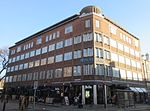Brighton Town Hall, England
Buildings and structures in Brighton and HoveCity and town halls in East SussexGovernment buildings completed in 1832Use British English from April 2022

Brighton Town Hall stands on Bartholomew Square in Brighton, East Sussex, England. The town hall contains a number of police cells which were in use until the 1960s, and which now form the Old Police Cells Museum. The town hall is a Grade II listed building.
Excerpt from the Wikipedia article Brighton Town Hall, England (License: CC BY-SA 3.0, Authors, Images).Brighton Town Hall, England
Bartholomew Square, Brighton Queen's Park
Geographical coordinates (GPS) Address External links Nearby Places Show on map
Geographical coordinates (GPS)
| Latitude | Longitude |
|---|---|
| N 50.8208 ° | E -0.1401 ° |
Address
Brighton Town Hall
Bartholomew Square
BN1 1JA Brighton, Queen's Park
England, United Kingdom
Open on Google Maps










